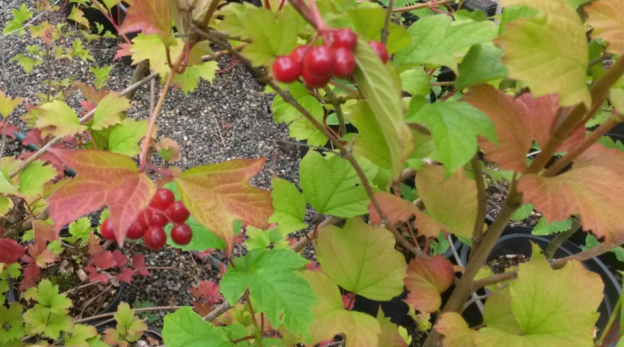American Cranberry Bush
Viburnum opulus L. var. americanum Aiton
(Vi-BUR-num OP-yoo-lus)
Names: The specific epithet, opulus appears to refer to the Italian Maple, Acer opalus (opalus for opal), due to its maple-like leaves, rather than any opulent characteristic. Viburnum opulus is sometimes called Highbush Cranberry in our region, but that name is more often used for Viburnum edule. The American Cranberry Bush (also known as V. trilobum) is a variety of the European Cranberry Bush. The species and some of it’s cultivated varieties are known in in other parts of the world as Guelder Rose, Water Elder, European Cranberrybush, Cramp Bark, or Snowball Tree.
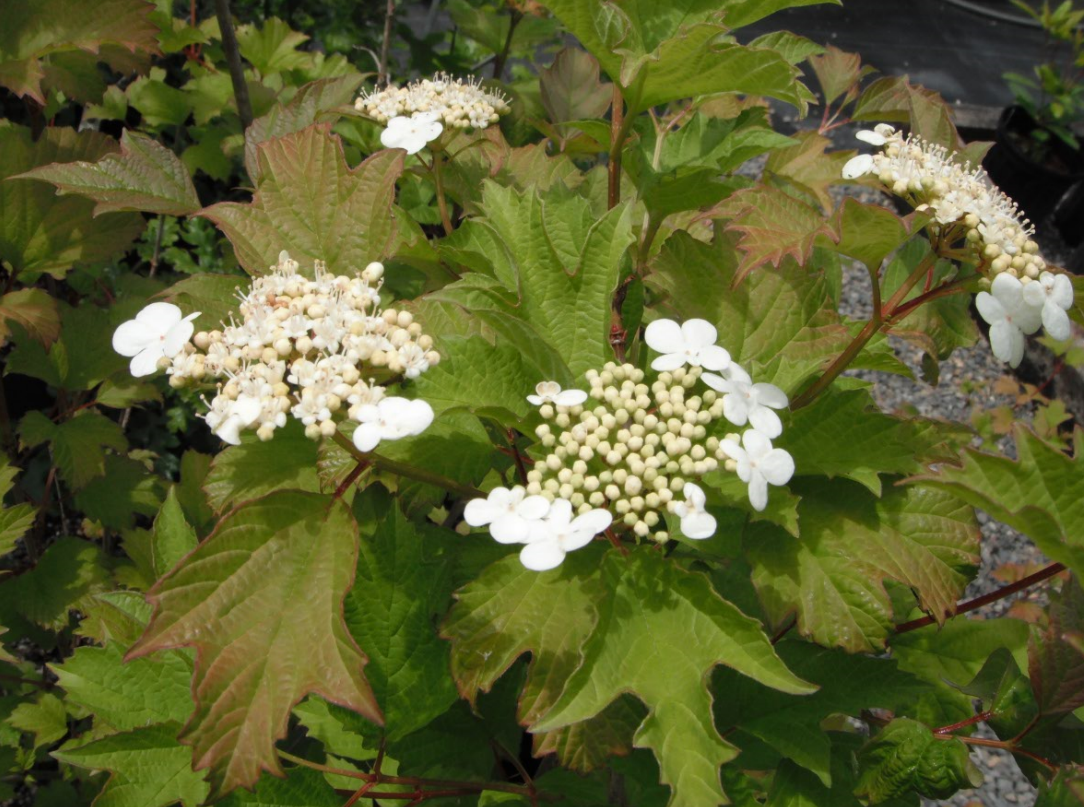
Relationships: There are about 150-175 species of Viburnum in temperate regions of the Northern Hemisphere with a few species found in mountainous regions of South America, Southeast Asia & Africa (in the Atlas Mountains). There are about 20 native to North America. Many species are popular garden and landscape plants. Several hybrids and cultivated varieties. have been developed. They are grown for their flower display and/or showy fruit, Some have fragrant flowers; some with attractive or unusual evergreen leaves or fall color.
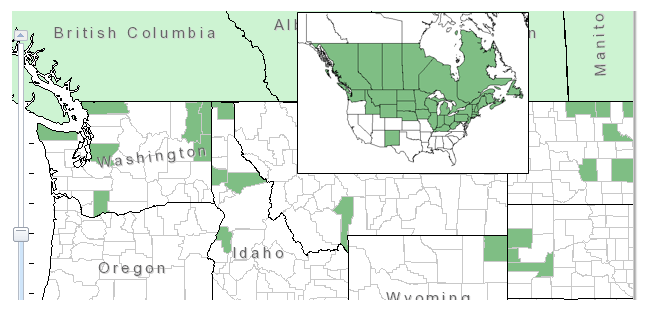
Distribution of American Cranberrybush from USDA Plants Database
Distribution: Viburnum opulus is also native to Europe, North Africa and Central Asia. It is found from southern British Columbia and in scattered locations in Washington State (on the fringes of Lake Washington, the Columbia River Gorge and near the Idaho border.); eastward, it is found sporadically across the northern United States and Canada, more common in the Great Lakes region to the eastern seaboard. American Cranberry Bush is listed as endangered in Indiana; threatened in Ohio; and rare in Pennsylvania. It is distinguished, with difficulty from the European form which occasionally escapes cultivation (more often in the eastern U.S.), by its skinnier somewhat longer stipules, and shorter, squatter petiolar glands.
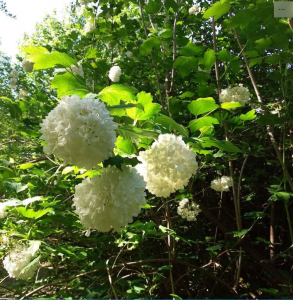
The popular cultivated Snowball Viburnum, Viburnum opulus ‘Sterile’
There are several cultivated varieties, including the well-known Snowball Shrub (or Tree), ‘Roseum’ (or ‘Sterile’), which gets its name from the snowball-shaped clusters of sterile flowers; it appears to have originated in the Dutch province of Gelderland, the derivation of its other common name, “Guelder Rose.”
Growth: This species can be a large shrub growing to 12-15 feet (1-4m) tall and as wide or wider.
Habitat: American Cranberrybush is found in moist, open woods. Wetland designation: FACW-, it usually occurs in wetlands, but is occasionally found in non-wetlands.
Diagnostic Characters: Opposite leaves are palmately 3- veined and 3-lobed and coarsely toothed. Flowers are a typical, white “lace-cap”—a flat-topped cluster of tiny flowers ringed with larger, showier, sterile flowers. Red, shiny fruits are berry-like drupes, each with a flattened stone.

In the Landscape: Having long been a garden favorite, Viburnum opulus, is an outstanding landscape shrub. The species has attractive lacy, white flowers in the summer, followed by bright red berries. It has spectacular fall color. This large, spreading shrub can be used as a specimen plant, for screens, or may be placed at the back of a shrub border. Children enjoy using the flower heads of the sterile form for spring time snowball fights!
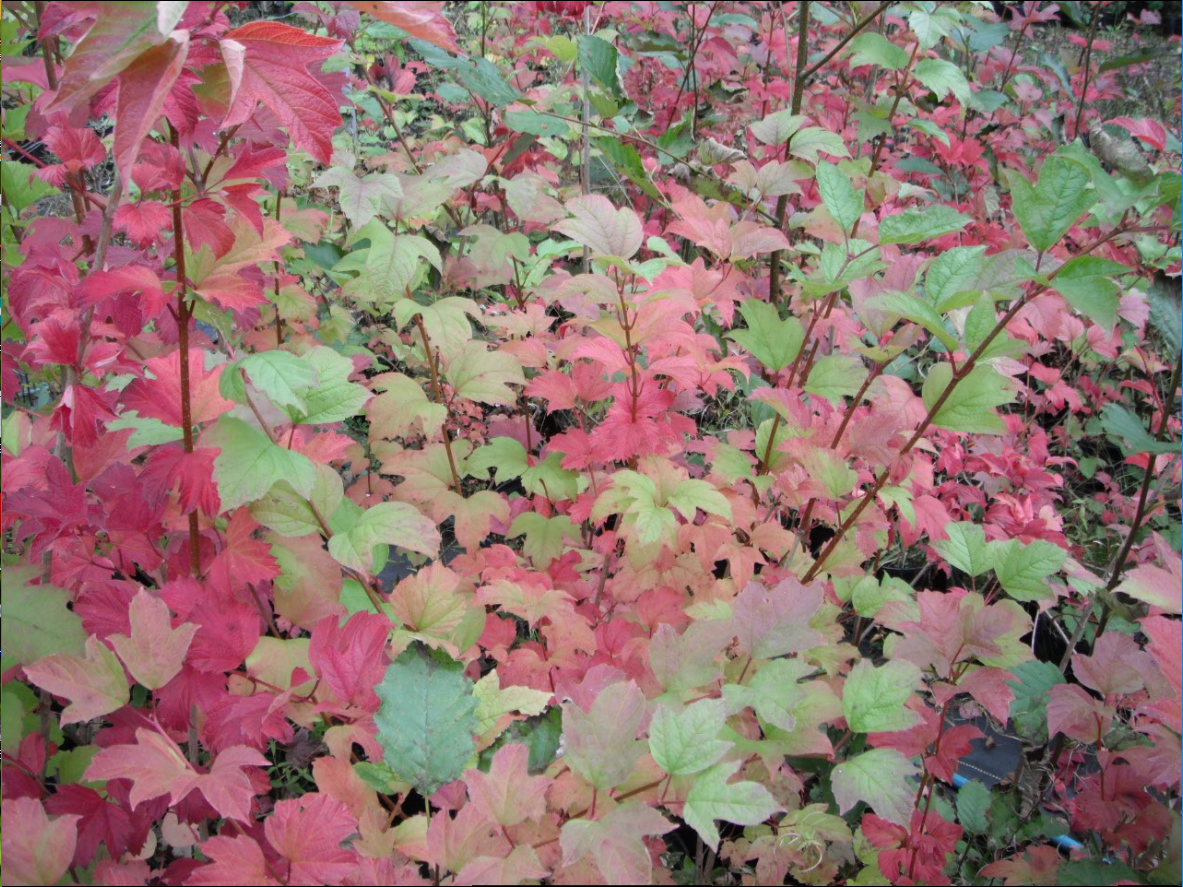
American Cranberrybush has spectacular fall color
Phenology: Bloom time: May-July; Fruit ripens: September-October. Persisting through winter.

Propagation: Seed propagation is difficult. Seed is best sown in a cold frame as soon as it is ripe; it may take more than 18 months to germinate. Stored seed requires 2 months warm and 3 months cold stratification and may still take 18 months or more to germinate. Cuttings root easily. Softwood cuttings may be taken in early summer; half-ripe wood in July or August; or mature wood in winter. Layering is also possible.
Use by people: Kalnya (Viburnum opulus) is a national symbol of Ukraine. Ancient Slavs associated it with the birth of the universe. Its berries symbolize blood and family roots. Kalyna is often depicted in Ukrainian embroidery. The fruit of European varieties tends to be bitter and is not used for food. The berries of American Cranberry Bush can be used as a cranberry substitute for making jellies and preserves, but the fruit may cause mild stomach upset when eaten unripe, and large quantities may cause vomiting and diarrhea. Some natives mashed the berries and dried them into cakes for future use. The dried bark has been used in preparations to alleviate painful menstrual or stomach cramps, hence the common name “Cramp Bark.” A red dye or ink may be made from the fruit. Stems without pith were used to make popguns in the absence of elderberry.
Use by Wildlife: Thrushes, robins, and Cedar Waxwings are considered the principal seed dispersers. The fruit is perhaps not a favorite of wildlife; it is not normally eaten by birds until after it has frozen and thawed several times. It is, however, known to be eaten by deer, moose, foxes, raccoons, chipmunks, squirrels, skunks, mice, rabbits, grouse, pheasants, and other songbirds. This large shrub provides cover and nesting sites for many small animals. It is a larval host for the Spring Azure Butterfly and sometimes attracts aphids. The flowers are pollinated by insects.
Links:
Consortium of Pacific Northwest Herbaria
WTU Herbarium Image Collection, Plants of Washington, Burke Museum
E-Flora BC, Electronic Atlas of the Flora of British Columbia
Jepson Eflora, University of California
Ladybird Johnson Wildflower Center
Native Plants Network, Propagation Protocol Database
Native American Ethnobotany, University of Michigan, Dearborn

